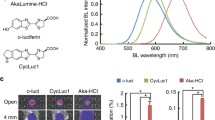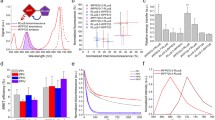Abstract
Purpose
Conventional in vivo bioluminescence imaging using wild-type green-emitting luciferase is limited by absorption and scattering of the bioluminescent signal through tissues. Imaging methods using a red-shifted thermostable luciferase from Photinus pyralis were optimized to improve the sensitivity and image resolution. In vivo bioluminescence imaging performance of red- and green-emitting luciferases were compared in two different xenograft mouse models for cancer.
Methods
Human hepatoblastoma cell line (HepG2) and human acute monocytic leukemia cell line (Thp1) cells were genetically engineered using retroviral vector technology to stably express the red-shifted or the wild-type green luciferase. A xenograft model of liver cancer was established by subcutaneous injection of the HepG2-engineered cells in the flank regions of mice, and a leukemia model was generated by intravenous injection of the engineered Thp1 cells. The cancer progression was monitored with an ultrasensitive charge-coupled device camera. The relative intensities of the green- and red-emitting luciferases were measured, and the resulting spatial resolutions of the images were compared. Imaging was performed with both intact and scarified live animals to quantify the absorption effects of the skin and deep tissue.
Results
The red-emitting luciferase was found to emit a bioluminescence signal with improved transmission properties compared to the green-emitting luciferase. By imaging the HepG2 models, which contained tumors just beneath the skin, before and after scarification, the percentage of light absorbed by the skin was calculated. The green bioluminescent signal was 75 ± 8% absorbed by the skin, whereas the red signal was only 20 ± 6% absorbed. The Thp1 model, which contains cancer cells within the bones, was likewise imaged before and after scarification to calculate the percentage of light absorbed by all tissue under the skin. This tissue was responsible for 90 ± 5% absorption of the green signal, but only 65 ± 6% absorption of the red signal.
Conclusion
Two different bioluminescent mouse cancer models demonstrate the utility of a new red-shifted thermostable luciferase, Ppy RE-TS, that improved the in vivo imaging performance when compared with wild-type P. Pyralis luciferase. While wild-type luciferase is currently a popular reporter for in vivo imaging methods, this study demonstrates the potential of red-emitting firefly luciferase mutants to enhance the performance of bioluminescence imaging experiments.







Similar content being viewed by others
References
Contag CH, Bachmann MH (2002) Advances in vivo bioluminescence imaging gene expression. Annu Rev Biomed Eng 4:235–260
Lyons SK (2005) Advances in imaging mouse tumour models in vivo. J Pathol 205:194–205
Dothager RS, Flentie K, Moss B, Pan M, Kesarwala A, Piwnika WD (2009) Advances in bioluminescence imaging of live animal models. Curr Opin Biotechnol 20:45–53
Henriquez NV, Van Overveld PGM, Buijs JT, Bachelier R, Kaijzel E, Löwik C WGM, Clezardin P, Van der Pujm G (2007) Advances in optical imaging and novel model systems for cancer metastasis research. Clin Exp Metastasis 24:699–705
Kazuki N, Yamada N, Enomoto T, Irie T, Kubota H, Ohmiya Y, Akiyama H, Ando Y (2007) Firefly bioluminescence quantum yield and colour change by pH-sensitive green emission. Nature Photonics 2:44–47
Tannous BA, Kim DE, Fernandez JL, Weissleder R, Breakefield XO (2005) Codon-optimized Gaussia luciferase cDNA for mammalian gene expression in culture and in vivo. Mol Ther 11:435–443
Loening AM, Wu AM, Gambhir SS (2007) Red-shifted Renilla reniformis luciferase variants for imaging in living subjects. Nat Methods 4:616–617
Cheong WF, Prahl SA, Welch AJ (1990) A review of the optical properties of biological tissues. IEEE J Quantum Electron 26:2166–2185
Tuchin V (200) Tissue opt. SPIE, Belligham, WA
Miloud T, Henrich C, Hämmerling GJ (2007) Quantitative comparison of click beetle and firefly luciferases for in vivo bioluminescence imaging. J Biomed Opt 12:054018
Branchini BR, Ablamsky DM, Murtiashaw MH, Uzasci L, Fraga H, Southworth TL (2007) Thermostable red and greed light-producing firefly luciferase mutants for bioluminescent reporter applications. Anal Biochem 361:253–262
O’Doherty U, Swiggard WJ, Malim MH (2000) Human immunodeficiency virus type 1 spinoculation enhances infection through virus binding. J Virol 74:10074–10080
Caysa H. Jacob R, Müther N, Branchini B, Messerle M, Söling A (2009) A redshifted codon-optimized firefly luciferase is a sensitive reporter for bioluminescent imaging. Photochem Photobiol Sci 8:52–56
Tonelli R, Sartini R, Fronza R, Freccero F, Franzoni M, Dongiovanni D,Ballarini M, Ferrari S, D’Apolito M, Di Cola G, Capranico G, Khobta A, Campanini R, Paolucci P, Minucci S, Pession A (2006) G1 cell-cycle arrest and apoptosis by histone deacetylase inhibition in MLL-AF9 acute myeloid leukemia cells is p21 dependent and MLL-AF9 independent. Leukemia 20:1307-1310
Keyaerts M, Verschueren J, Bos TJ, Tchouate-Gainkam LO, Peleman C, Breckpot K, Vanhove C, Caveliers V, Bossuyt A, Lahoutte T (2008) Dynamic bioluminescence imaging for quantitative tumor burden assestment usin IV or IP administration of d-luciferin: effect on intensity, time kinetics and repeatability of photon emission. Eur Mucl Med Mol Imaging 35:999–1007
Berger F, Paulmurugan R, Bhaumik S, Gambhir SS (2008) Uptake kinetics and biodistribution of 14C-d-luciferin—a radiolabeled substrate for the firefly luciferase catalyzed bioluminescence reaction: impact on bioluminescence based reporter gene imaging. Eur J Nucl Med Mol Imaging 35:2275–2285
Rettig GR, McAnuff M, Liu D, Kim J,Rice KG (2006) Quantitative bioluminescence imaging of transgene expression in vivo. Anal Biochem 355:90–94
Paroo Z, Bollinger RA, Braasch DA, Richer E, Corey DR, Antich PP, Mason RP (2004) Validating bioluminescence imaging as a high-throughput, quantitative modality for assessing tumor burden. Mol Imaging 3:117–124
Zhao H, Doyle TC, Coquoz O, Kalish F, Rice, BW, Contag CH (2005) Emission spectra of bioluminescent reporters and interaction with mammalian tissue determine the sensitivity of detection in vivo. J Biomed Opt 10:41210
Shu ST, Nadella MV, Dirksen WP, Fernandez SA, Thundi NK, Werbeck JL, Lairmore MD, Rosol TJ (2007) A novel bioluminescent mouse model and effective therapy for adult T-cell leukemia/lymphoma. Cancer Res 67:11859–11866
Li S, Zhang Q, Jiang H (2006) Two-dimensional bioluminescence tomography: numerical simulations and phantom experiments. Appl Opt 45:3390–3394
Ntziachristos V, Ripoll J, Wang LV, Weissleder R (2005) Looking and listening to light: the evolution of whole-body photonic imaging. Nat Biotechnol 23:313–320
Chaudhari AJ, Darvas F, Bading JR, Motas RA, Conti PS, Smith DJ, Cherry SR, Leathy RM (2005) Hyperspectral and multispectral bioluminescence optical tomography for small animal imaging. Phys Med Biol 50:5421–5441
Acknowledgments
We acknowledge financial support by the Air Force Office of Scientific Research (FA9550-07-1-0043), the National Science Foundation (MCB0444577 and MCB0842831). We thank Danielle Ablamsky and Tara Southworth for technical assistance, and Audrey Davis for helpful discussions. We thank Prof. Andrew Kung for the pMMP-lucneo vector. This work was supported in part by CARISBO Foundation (Bologna) and AIRC (Italian Association for Cancer Research).
Author information
Authors and Affiliations
Corresponding author
Rights and permissions
About this article
Cite this article
Mezzanotte, L., Fazzina, R., Michelini, E. et al. In Vivo Bioluminescence Imaging of Murine Xenograft Cancer Models with a Red-shifted Thermostable Luciferase. Mol Imaging Biol 12, 406–414 (2010). https://doi.org/10.1007/s11307-009-0291-3
Received:
Accepted:
Published:
Issue Date:
DOI: https://doi.org/10.1007/s11307-009-0291-3




